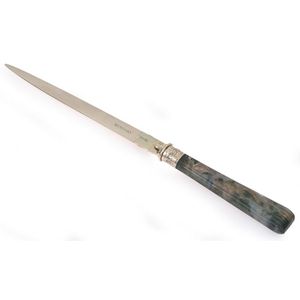Art Deco Diamond Brooch with Onyx and Platinum
An Art Deco diamond brooch, platinum set on an 18ct gold ground centring a millegrain set old European cut diamond of approx. 0.08ct between scroll pierced sides, one set with an old European cut diamond the other with an early single cut diamond to a surround of 18 mixed old European, early single and rose cut diamonds, the shoulders each set with 2 rose cut diamonds a square and pentagonal shape onyx, length 66 mm, wt. 5.41g, Netherland marks, boxed.
You must be a subscriber, and be logged in to view price and dealer details.
Subscribe Now to view actual auction price for this item
When you subscribe, you have the option of setting the currency in which to display prices to $Au, $US, $NZ or Stg.
This item has been sold, and the description, image and price are for reference purposes only.
- Onyx - Onyx is a form of agate, used from antiquity and popular again in the 1920s and 30s. European onyx is generally green, but can be many other colours, and can contain bands of black and/or white.
This multicoloured stone is widely used for table tops, lamp bases and in jewellery. Some types of onyx are also used for cameos of which the upper white layer is cut away to reveal the colour beneath. - Rose Cut - A flat based cut for a preious stone, leaving the surface covered with triangular facets, usually 24 in total.
It was introduced in the 15th century and popular during the 16th and 17th centuries.
The rose cut was the most popular form of diamond cut until the discovery of the brilliant cut at the end of the 17th century, after which its use declined. - Art Deco Period - The Art Deco period was a cultural movement that emerged in the 1920s and 1930s, and was characterized by its emphasis on modernism, luxury, and elegance. The name "Art Deco" comes from the Exposition Internationale des Arts Décoratifs et Industriels Modernes, a large exhibition held in Paris in 1925 that showcased the latest trends in decorative arts.
Art Deco was a reaction against the ornate and elaborate styles of the previous era, and reflected a new modern sensibility. It was characterized by streamlined, geometric shapes, bright colours, and the use of new materials such as chrome, glass, and Bakelite. Art Deco designers sought to create a sense of luxury and sophistication, often incorporating expensive materials such as ivory, marble, and rare woods.
Art Deco had a significant impact on a wide range of artistic fields, including architecture, fashion, graphic design, and interior design. Some of the most iconic examples of Art Deco architecture include the Empire State Building in New York City, the Hoover Building in London, and the Palais de Chaillot in Paris.
The Art Deco period came to an end in the 1940s, as World War II and changing cultural trends led to a shift in artistic styles. However, Art Deco remains an important influence on design and art, and continues to be celebrated for its modernist sensibility and glamorous aesthetic. - Millegrain - A type of jewellery setting where the stone is held is held in position by small adjacent beads of metal. This method of securing the stone was popular in the 19th century.
This item has been included into following indexes:
Visually similar items

Sterling silver Japanese embossed dip pen
Sold by
in
for
You can display prices in $Au, $US, $NZ or Stg.

Bulova, ladies watch, 18ct yellow gold bracelet and case, cream dial, manual wind movement, case stamped 'Bulova MO18KT'. Weight 40 grams
Sold by
in
for
You can display prices in $Au, $US, $NZ or Stg.

Sold by
in
for
You can display prices in $Au, $US, $NZ or Stg.

A silver and agate paper knife, comprising a modern silver blade with vintage silver mount and green agate handle. Vintage scroll design mount hallmarked Sheffield and dated 1921. Maker: J.B.
Sold by
in
for
You can display prices in $Au, $US, $NZ or Stg.
